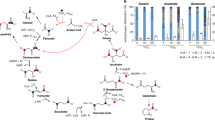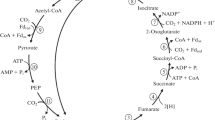Abstract
Autotrophic CO2 fixation byMethanobacterium thermoautotrophicum proceeds via a total synthesis of activated acetic acid. The origins of the individual carbon atoms were studied in vitro and in vivo. The experiments described showed:
-
(1)
Two different routes of CO2 reduction lead to the individual carbon positions in acetate.
-
(2)
The carboxyl carbon is provided by a cyanide-sensitive enzyme which reduces CO2 to a bound intermediate with the oxidation state of CO. This intermediate can be supplied by gaseous CO rather than by formate, when its synthesis from CO2 is blocked by cyanide. The characteristics of the enzymic reaction are those of carbon monoxide dehydrogenase.
-
(3)
The methyl carbon is derived from CO2 via a different cyanide-insensitive CO2 reduction path, which probably shares the initial intermediates of methanogenesis from CO2 and H2. It does not involve methyl coenzyme M. It is concluded that the pathway of autotrophic CO2 assimilation into activated acetic acid inMethanobacterium is mechanistically related to the clostridial total acetate synthesis.
Similar content being viewed by others
References
Allen TH, Root WS (1955) Colorimetric determination of carbon monoxide in air by an improved palladium chloride method. J Biol Chem 216:309–317
Brandis A, Thauer RK, Stetter KO (1981) Relatedness of strains Δ H and Marburg ofMethanobacterium thermoautotrophicum. Zbl Bakt Hyg, I. Abt Orig C 2:311–317
Conrad R, Thauer RK (1983) Carbon monoxide production byMethanobacterium thermoautotrophicum. FEMS Microbiol Lett 20:229–232
Daniels L, Zeikus JG (1978) One-carbon metabolism in methanogenic bacteria: analysis of short-term fixation products of14CO2 and14CH3OH incorporated into whole cells. J Bacteriol 136:75–84
Daniels L, Fuchs G, Thauer RK, Zeikus JG (1977) Carbon monoxide oxidation by methanogenic bacteria. J Bacteriol 132:118–126
Diekert G, Ritter M (1983) Carbon monoxide fixation into the carboxyl group of acetate during growth ofAcetobacterium woodii on H2 and CO2. FEMS Microbiol Lett 17:299–302
Drake HL, Hu SI, Wood HG (1981) Purification of five components fromClostridium thermoaceticum which catalyze synthesis of acetate from pyruvate and methyltetrahydrofolate. J Biol Chem 21:11137–11144
Eden G, Fuchs G (1982) Total synthesis of acetyl CoA involved in autotrophic CO2 fixation inAcetobacterium woodii. Arch Microbiol 133:66–74
Eikmanns B, Thauer RK (1984) Catalysis of an isotope exchange between CO2 and the carboxyl group of acetate byMethanosarcina barkeri grown on acetate. Arch Microbiol (submitted)
Ellefson WL, Wolfe RS (1980) Role of component C in the methylreductase system ofMethanobacterium. J Biol Chem 255:8388–8389
Ferry JG, Sherod DW, Peck HD, Ljungdahl LG (1976) Levels of formyltetrahyrofolate synthetase and methylenetetrahydrofolate dehydrogenase in methanogenic bacteria. In: Schlegel HG, Gottschalk G, Pfennig N (eds) Microbial production and utilization of gases (H2, CH4, CO). Goltze, Göttingen, pp 151–155
Friedrich W (1975) Vitamin B12 und verwandte Corrinoide. In: Ammon R, Dirscherl W (eds) Fermente, Hormone, Vitamine, vol III/2, 3rd edn. Thieme Stuttgart, pp 1–97
Fuchs G, Stupperich E (1982) Autotrophic CO2 fixation pathway inMethanobacterium thermoautotrophicum. In: Kandler O (ed) Archaebacteria. Fischer Stuttgart New York, pp 277–288
Fuchs G, Stupperich E (1983) CO2 fixation pathways in bacteria. Physiol Veg 21:845–854
Fuchs G, Stupperich E (1984) CO2 reduction to cell carbon in methanogens. In: Microbial growth on C1-compounds. (in press)
Fuchs G, Schnitker U, Thauer RK (1974) Carbon monoxide oxidation by growing cultures ofClostridium pasteurianum. Eur J Biochem 49:111–115
Fuchs G, Stupperich E, Thauer RK (1978) Acetate assimilation and the synthesis of alanine, aspartate and glutamate inMethanobacterium thermoautotrophicum. Arch Microbiol 117:61–66
Fuchs G, Stupperich E, Eden G (1980) Autotrophic CO2 fixation inChlorobium limicola. Evidence for the operation of a reductive tricarboxylic acid cycle in growing cells. Arch Microbiol 128: 64–71
Grassl M (1974) Alanin-Bestimmung mit GPT und LDH. In: Bergmeyer HU (ed) Methoden der enzymatischen Analyse, vol 2. Verlag Chemie, Weinheim, pp 1727–1730
Gunsalus RP, Wolfe RS (1977) Stimulation of CO2 reduction to methane by methyl-coenzyme M in extracts ofMethanobacterium. Biochem Biophys Comm 76:790–795
Gunsalus RP, Wolfe RS (1980) Methyl coenzyme M reductase fromMethanobacterium thermoautotrophicum. J Biol Chem 255:1891–1895
Gunsalus RP, Romesser JA, Wolfe RS (1978) Preparation of coenzyme M analogues and their activity in the methyl coenzyme A reductase system ofMethanobacterium thermoautotrophicum. Biochemistry 17:2374–2377
Hohorst HJ (1970)l-(+)-Lactat-Bestimmung mit Lactat-Dehydrogenase und NAD. In: Bergmeyer HU (ed) Methoden der enzymatischen Analyse, vol 2. Verlag Chemie, Weinheim, pp 1425–1429
Hu SI, Drake HL, Wood HG (1982) Synthesis of acetyl coenzyme M from carbon monoxide, methyltetrahydrofolate, and coenzyme A by enzymes fromClostridium thermoaceticum. J Bacteriol 149:440–448
Jansen K, Thauer RK, Widdel F, Fuchs G (1984) Carbon assimilation pathways in sulfate reducing bacteria. Formate, CO2, carbon monoxide, and acetate assimilation byDesulfovibrio baarsii. Arch Microbiol (submitted)
Keltjens JT, Vogels GD (1981) Novel coenzymes of methanogens. In: Dalton H (ed) Microbial growth on C1 compounds. Heyden, London Philadelphia Rheine, pp 152–158
Keltjens JT, Caerteling G, van Kooten A, van Dijk H, Vogels GD (1983a) 6,7-Dimethyl-8-ribityl-5,6,7,8-tetrahydrolumazine, a proposed constituent of coenzyme MF430 from methanogenic bacteria. Biochim Biophys Acta 743:351–358
Keltjens JT, Daniels L, Jannsen HG, Borm PJ, Vogels GD (1983b) A novel one-carbon carrier (carboxy-5,6,7,8-tetrahydromethanopterin) isolated fromMethanobacterium thermoautotrophicum and derived from methanopterin. Eur J Biochem 130:545–552
Kenealy W, Zeikus WG (1981) Influence of corrinoid antagonists on methanogen metabolism. J Bacteriol 146:133–140
Kenealy WR, Zeikus JG (1982) One-carbon metabolism in methanogens: Evidence for synthesis of a two-carbon cellular intermediate and unification of catabolism and anabolism inMethanosarcina barkeri J Bacteriol 151:932–941
Leigh JA (1983) Levels of water-soluble vitamins in methanogenic and nonmethanogenic bacteria. Appl Environ Microbiol 45:800–803
Leigh JA, Wolfe RS (1983) Carbon dioxide reduction factor and methanopterin, two coenzymes required for CO2 reduction to methane by extracts ofMethanobacterium. J Biol Chem 258:7536–7540
Ljungdahl L, Wood HG (1982) Acetate synthesis. In: Dolphin D (ed) Vitamin B12. Academic Press, New York, pp 165–202
Müller O, Müller G (1962) Synthesen auf dem Vitamin B12-Gebiet. XIV. Über die Synthese von Corrinoiden mit Kobalt-Kohlenstoff-Bindung. Biochem 336:299–313
Oberlies G, Fuchs G, Thauer RK (1980) Acetate thiokinase and the assimilation of acetate inMethanobacterium thermoautotrophicum. Arch Microbiol 128:248–252
Poston JM, Kuratomi K, Stadtman ER (1966) The conversion of carbon dioxide to acetate. I. The use of cobalt-methylcobalamin as a source of methyl groups for the synthesis of acetate by cell-free extracts ofClostridium thermoaceticum. J Biol Chem 241:4209–4219
Romesser JA, Wolfe RS (1982) Coupling of methyl Coenzyme M reduction with carbon dioxide activation in extracts ofMethanobacterium thermoautotrophicum. J Bacteriol 152:840–847
Schönheit P, Moll J, Thauer RK (1980) Growth parameters (K s,μ max,Y s) ofMethanobacterium thermoautotrophicum. Arch Microbiol 127:59–65
Simon H, Floss HG (1967) Bestimmung der Isotopenverteilung in markierten Verbindungen. Springer, Berlin Heidelberg New York
Simon H, Palm D (1966) Isotope effects in organic chemistry and biochemistry. Angew Chem 5:920–933
Stupperich E, Fuchs G (1983) Autotrophic acetyl coenzyme A synthesis in vitro from two CO2 inMethanobacterium. FEBS Lett 156:345–348
Stupperich E, Fuchs G (1984) Autotrophic synthesis of activated acetic acid from two CO2 inMethanobacterium thermoautotrophicum. Properties of in vitro system. Arch Microbiol 139:8–13
Stupperich E, Hammel KE, Fuchs G, Thauer RK (1983) Carbon monoxide fixation into the carboxyl group of acetyl coenzyme A during autotrophic growth ofMethanobacterium. FEBS Lett 152:21–23
Taylor CD, Wolfe RS (1974) Structure and methylation of coenzyme M (HSCH2CH2SO3). J Biol Chem 249:4879–4885
Thauer RK, Fuchs G, Käufer B, Schnitker U (1974) Carbon monoxide oxidation in cell-free extracts ofClostridium pasteurianum. Eur J Biochem 45:343–349
Thauer RK, Diekert G, Schönheit P (1980) Biological role of nickel. Trends Biochem Sci Vol 5 No 11, 304–349
Vogels GD, Visser CM (1983) Interconnection of methanogenic and acetogenic pathways. FEMS Microbiol Letters 20:291–297
Vogels GD, Keltjens JT, Hutten TJ, van der Drift C (1982) Coenzymes of methanogenic bacteria. In: Kandler O (ed)Archaebacteria. Fischer, Stuttgart New York, pp 258–264
Wolfe RS (1979) Methanogens: a surprising microbial group. Antonie van Leeuwenhoek 45:353–364
Wolfe RS, Higgins IJ (1979) Microbial biochemistry of methane —a study in contrasts. Rev Biochem 21:267–300
Author information
Authors and Affiliations
Rights and permissions
About this article
Cite this article
Stupperich, E., Fuchs, G. Autotrophic synthesis of activated acetic acid from two CO2 inMethanobacterium thermoautotrophicum . Arch. Microbiol. 139, 14–20 (1984). https://doi.org/10.1007/BF00692705
Received:
Accepted:
Issue Date:
DOI: https://doi.org/10.1007/BF00692705




